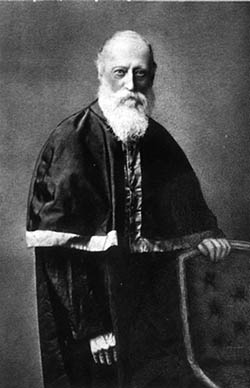John Lake CROMPTON 1815 - 1889
Born 15th November 1815, Norwich, son of Alice PENTIN (1786–1873)
Died 3rd August 1889, Buried St Andrew's Church, Pinetown, Natal
Married 25 November 1854 in Funchal, Madera, to Harriet PHELPS (1828–1925)
John and Harriet had ten children:
Children
Theodore (1855–1867)
Eustace (1857–1933)
Bede (1859–1934)
Beatrice (1861–1944)
Mary (1864–1948)
Agnes (1866–1930)
Harriet (1868–1904)
Cecilia (1870–1919)
Katherine (1871–1877)
Godfrey (1873–1950)
John
John's baptismal record shows his given names as John Lake, son of Alice PENTIN, with no father shown, though the entry in the Cambridge University calendar lists him as "LAKE (later Crompton) John, son of Thomas, surgeon, deceased." In May 1830 in Chelsea, Middlesex, Alice Pentin married the 71-year-old Rev Thomas CROMPTON a childless widower, twenty-eight years her senior, who then adopted John and his younger brother. John went to Mr Allard's school in Brompton and then to Cambridge and adopted the name Crompton. Thomas Crompton died in 1838 leaving the bulk of his estate to his wife, in trust for her two sons.
John obtained a BA degree in 1837 and was ordained deacon at Gloucester in 1838 and priest in 1839. He was curate of Wyck Rissington, Gloucester 1838 to 1840 then of Marylebone All Saints 1840 to 1853. In March 1838 John obtained a British passport in London and travelled extensively in Europe. He probably returned to England now and then, though he can't have spent much time in the parishes where he was curate. We have a number of letters written by John to his mother during 1849, from France and Spain. He suffered from a weak throat and, as well as drinking the waters at various health resorts, he kept moving south in search of warmer climates.
In 1851 he went via the Canary Islands to Madeira. There he met the Phelpses, a musical family who were very involved with the English Church and always hospitable to visitors from England. Harriet was in England at the time, so they didn't meet until the following year. Alice visited her son in Funchal in the summer of 1854 and John then accompanied her back to England. By this time John and Harriet had become engaged and they were married in Funchal in November 1854. They had a civil ceremony before the British Consul, followed by a church service and a lavish reception at the Carmo. John insisted that Harriet's father settle £1000 on her when they married so Joseph Phelps insisted that John do likewise. Part of Harriet's dowry was paid in pipes of wine.
Harriet and John moved into a new house which Joseph Phelps had recently had built, in the Rua de Phelps close to the Carmo. Their first child Theodore, was born there but John was keen to move to an English-speaking country with a warm climate and they decided on Natal, sailing from England in December 1856 on the Admiral, where he was instrumental in quelling a mutiny on board. After a voyage of three months, and two months spent in Durban, they settled at Pinetown at a former hostelry Fort Funk, which John purchased and renamed Breightmet after an estate of the Crompton family in Lancashire.
John soon began buying land in the Pinetown and Durban areas. He also lent money on mortgages and earned the nickname "six-per-cent", the rate of interest he charged, not hesitating to foreclose when borrowers could not pay. Later he acquired large tracts of land on the coast as far north as Tongaat and in the Winterskloof, Rosetta and Mooi River areas, including the farm "Crompton Fold" near Rosetta which his son Bede farmed and later inherited.
Many of John's letters to his mother have survived and these show him as a devoted son and affectionate father, if not particularly considerate towards his wife, who had to cope with primitive conditions, untrained servants and frequent childbearing.
John's involvement with the Church of England in Natal was far from harmonious. Essentially John was an academic with a devotion to dogma and ritual, and a stickler for high church observance. He clashed with anyone who was prepared to relax the rules in any way, especially John William Colenso, the Bishop of Natal. Crompton's attempts to depose Colenso and have him excommunicated were supported by Dean Green and some others. John built St Andrew's Church in Pinetown as he disapproved of the services held at the existing St John's Church. He also added a chapel to Breightmet, in defiance of Colenso who refused permission for this.
John got on well with Bishop Macrorie who was appointed Bishop of the Diocese of Maritzburg in 1869 and made John a Canon of his cathedral St Saviour's. John assisted in the arrangement of music for a Zulu prayer book and Zulu hymns. There is a certain irony in this because Colenso had published a Zulu dictionary in 1861 and was the first person to make Zulu a written language.
John died at Breightmet in 1889 and was buried at St Andrew's Churchyard, Pinetown.
